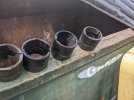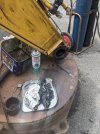You have to study mechanical properties and toughness curve in different HT states to arrive at the properties you desire. All those pins run in double shear, which can be simple to calculate, but then you have to assess the forces on the pin to arrive at an estimated fatigue life. In something like this, infinite should be the goal on those pins.
Case or surface hardening is solely a means to reduce wear, but it is common to push for a deeper case thickness to actually improve mechanical properties, but it is rarely advisable to through harden to a high HRC. Indeed you bring embrittlement with high HRC.
This is why I'd like to know what the OEMs do/use, to better understand their strategy. Personally, I would never want a pin case hardness higher than my bushings. I probably would not want chrome pins as that hardness is certain to be higher than the bush material. However, this would assume you could simply swap pins to "fix" a problem and I don't think that strategy is common. Even with dissimilar hardness, both components will wear. Another reason to never match hardness is galling. I would expect the bushings to be of a different alloy to further ensure that doesn't happen.
It would be interesting to cold cut a hydro rod away from any welds and analyze the hardness from the outside, inward. If I had to guess, I would say HRC 50-55 on the outside under the chrome, and HRC 35-40 in the center. The very standard 4140HT at HRC28-32 is actually still pretty soft for a friction wear item, but that temper gives good general mechanical properties. Any good OEM or MFG would buy annealed and do their own HT spec.


